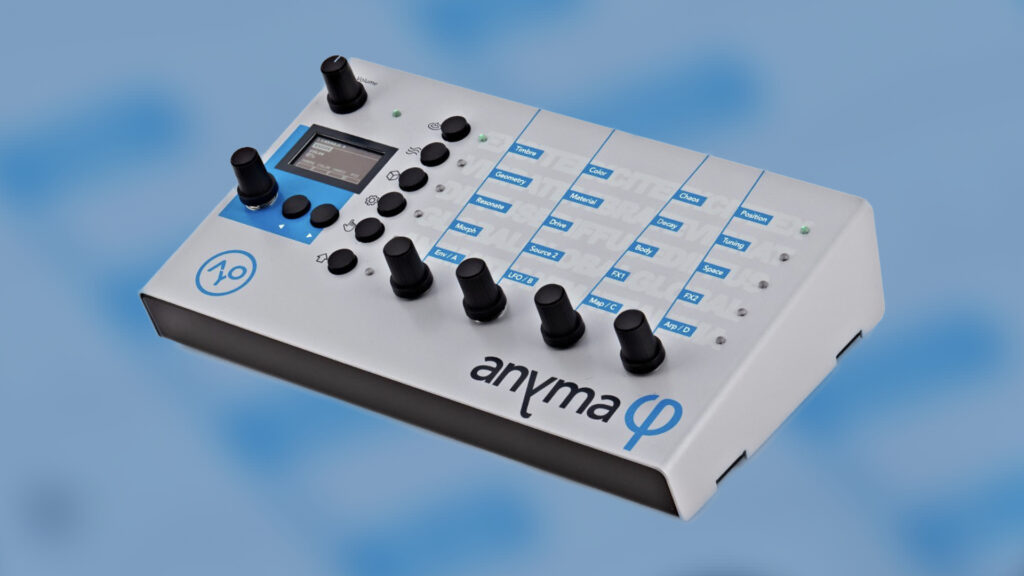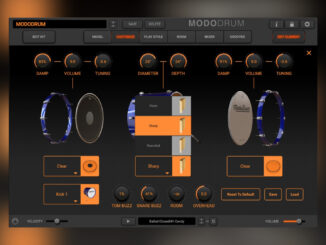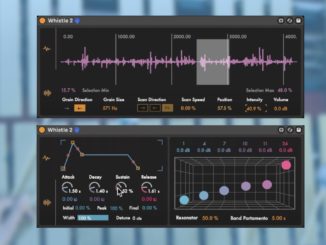Aodyo Instruments’ compact physical modeling synth Anyma Phi is growing up in update 1.0 with paraphony, new oscillators, chaos modulators…
At Superbooth 21, the French developers from Aodyo Instruments showed the Anyma Phi to the public for the first time at a synth event. A compact matrix-based physical modeling Synthesizer with a rich feature set. I made a first look and interview video about it, linked below.
As some already noted there, the synth was not 100% finished yet. Some features were missing or there were also bugs. Nothing extraordinary in a synth that is fresh out of the oven. Especially with a complex digital one. But who knows, a bug can also be a feature.

Aodyo Instruments Anyma Phi 1.0
In the last few months, the firmware has been diligently expanded, fine-tuned and fixed. The first major update 1.0 of the Anyma Phi is in open beta right know. It’s a huge update so grab a cup of coffee as there will be a lot to discover
Paraphony & Oscillators
Starting with the whole engine, which now supports paraphony with up to 3 notes (one oscillator per note). A new replicant oscillator is added to simplify the workflow. Unfortunately no polyphony yet, but paraphony is a good step forward.
Anyma Phi 1.0 firmware expands the oscillator section massively. A new exciter group gives you three new oscillators that can be used exclusively with the resonator effects. It includes:
- Bow simulates the raw sound of a bow scratching a material.
- Wind simulates a variety of continuous blowing, breathing, or wind noises.
- Strike, the snare drum resonator simulates a variety of impulses and percussive noises: hammers, mallets, sticks, plectrums, or bouncing particles (using the Mallet parameter)
Besides the resonators, firmware 1.0 also introduces a brand-new side of the Anyma Phi. You can now select a virtual analog oscillator with continuous waveform selection (sine, triangle, sawtooth, square, pulse) with the ability to turn it in a linear through-zero FM operator. You can have up to 5 operators, each with an oversampling option and plus 3 oscillators.
Also new is a modeled drawbar organ oscillator. Lots of new timbres to discover.

Effects
The effects section is just as exciting and feature-intensive. Firmware 1.0 adds a new dirty formant filter, granular processor for endless textures, ping-pong delay, a rotating speaker effects (mono/stereo) for the new drawbar organ oscillator…. And a group of three new dynamic effects including noise gate, compressor and a dynamics booster.
Big Step For The Modulation Engine
The modulation section gets a massive upgrade as well. I’m not exaggerating. You will find an improved envelope follower that allows you to extract a modulation from an audio signal, now with noise gate and gain.
Then, it comes with new audio-based modulations. Drum trigger is an envelope follower designed specially for percussion while timbre follower extracts the brightness of your signal. So you can discriminate between tapping with your thumb or with a screwdriver (?), or between singing a low C and a high A.
Aodyo unleashes chaos in this update as well with a new chaos modulator group. You get: Logistic map, Tent map, Circle map, and Discrete chaotic map offer you four different equations for controlled or chaotic modulations. Plus, it includes a 32-cell elementary Cellular automaton in which you can freely modulate the rule and initial stage.

Another highlight in the boosted modulation engine are the new algorithmic and physics modulator group with different creative types: Euclidean sequencer, hexadecimal sequencer (any 32-bit nuber into a groove), physical models that simulate the movement of a single ball or multiple (bouncing ball, ball impact) as well spring-damper system. The latter allows you attach a spring to any input value.
Also new is a compare modulator and a logic modulator group with 5 additional modulators with the focus on triggers and gates: gate combinator, trigger combinator, gate to trigger, gate delay, trigger delay). A change polarity modulator turns unipolar value into bipolar ones and last a slow variant of the advanced LFO.
And MORE
And goes even further. Firmware 1.0 adds an arpeggiator with 15 different patterns including a creative trigger mode, microtuning support (MTS SysEx + MTS-ESP), AI-based patch randomizer, autofill matrix functionality, limited Linux editor support, and more.
The full release notes are available here
An update worthy of the name. I’ve rarely seen a synth get so many new features in a single firmware update. It also has to be said that the synth wasn’t finished at the time of Superbooth 21.
I am very happy to see that the Anyma Phi has received so much care in the last months. Especially considering all the musicians who have backed the synth on Kickstarter. I think they can be very happy. I hope that the update will not only boost the features but also the sales.
Availability
The new Aodyo Instruments Anyma Phi update 1.0 is available now in beta. You can download it from the official forum.
More information here: Aodyo Instruments
Available at our partner




I was an early backer. I’m glad they delivered and exceeded tbh. I had it laying around and haven’t used it because it wasn’t finished.
I knew it had lots of potential though so I’m very happy with the work they’ve done so far, and it seems they’ll keep working on it even more.
This really is an incredible update for an already very cool bit of gear. Glad I picked one up and thrilled that Aodyo went so big for this update. A synth and company to watch and I hope this gem gets the attention it deserves. Bravo!
What is the point of this when the same thing and more could be done in software?
There are two music world, or even three: hardware, software and hybrid musicians. Many make music in the computer with all its advantages and disadvantages. Others want it hands-on and in hardware. This is because: many work 8 or more hours and sit in front of the computer. So many don’t want to use a computer to make music. I can understand it. All three worlds have pro and cons. I’m fine with all three.